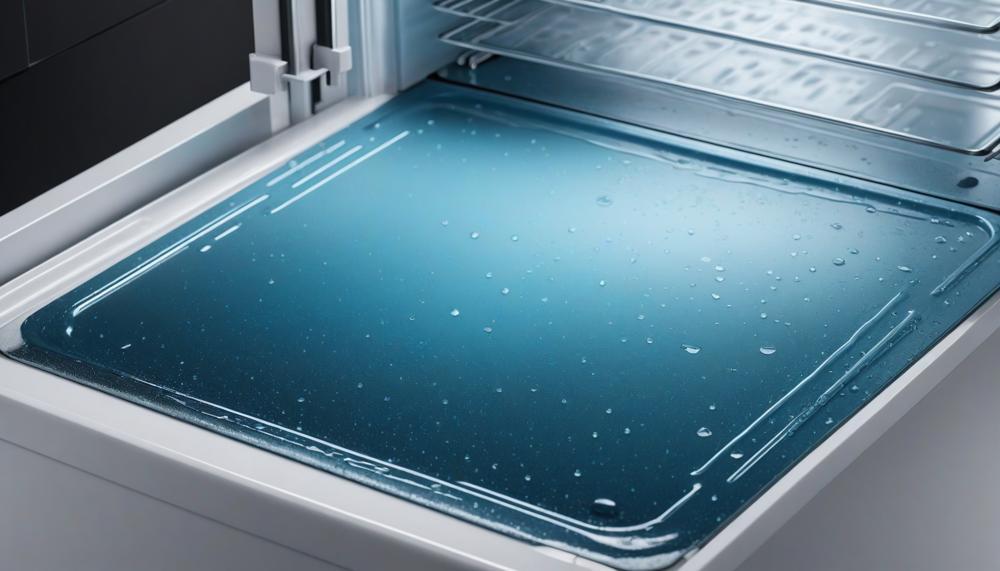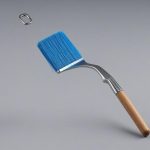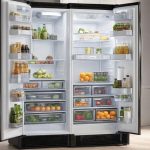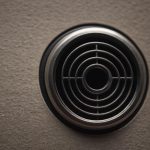Have you ever noticed a bit of water in the drip pan under your refrigerator and wondered if it’s normal? The answer is yes—having water in the drip pan is a sign that your refrigerator is functioning properly. But just how much water should there be? A full drip pan is perfectly normal and indicates that the appliance is working as designed.
The drip pan’s primary job is to catch and evaporate small amounts of water resulting from the refrigerator’s internal condensation and defrosting cycles.
However, if you’re seeing excessive water, it might point to underlying issues. Too much water can be due to excess frost inside the refrigerator, often a result of a malfunctioning defrost function, or it could be from a faulty door gasket that allows warm air to enter, causing more condensation.
Key Takeaways:
- Normal Water Level: A full drip pan is normal and shows the refrigerator is working as it should.
- Excess Water Issues: Too much water might signal excess frost or a faulty door gasket.
- Maintenance Tip: Regularly check the drip pan to ensure it’s not overflowing, indicating potential problems.

Understanding the role of the drip pan and monitoring its water level can help you keep your refrigerator running efficiently and prevent minor issues from becoming major headaches.
Contents
Top Home Maintenance Tips straight to your inbox.
Checking and Maintaining Your Refrigerator Drip Pan
Regular Cleaning
- Location: Find the drip pan at the bottom of your fridge, typically behind a panel or grill.
- Frequency: Clean every three months to avoid dirt, debris, and mold buildup.
- Method: Use mild soap and warm water. Rinse thoroughly and dry before placing it back.
Monitoring Water Levels
- After Heavy Use: Check the drip pan after parties or during hot weather when the fridge is opened frequently.
- Indications: Excess water may signal an issue with the cooling system. In such cases, consult a professional.
Inspecting Door Seals
- Frequency: Monthly checks for cracks or wear.
- Importance: Damaged seals can cause air leaks, leading to more condensation and water in the drip pan.
- Replacement: Replace worn-out seals promptly to maintain efficiency.
Manufacturer Updates
- Sign Up: Register for newsletters or emails from your fridge’s manufacturer.
- Benefits: Get specific maintenance instructions and tips for your model.
Optimal Water Levels and Common Issues
| Condition | Signs | Actions |
| Normal Operation | Small amount of water in drip pan | Regularly clean and check the pan. |
| Excess Water | Frequent need to empty the pan | Inspect for excess frost or faulty door seals. Contact a professional if issues persist. |
| Dry Pan | No water in the pan | Ensure the defrost cycle is working properly. Check for clogs in the drain line. |
What Is a Refrigerator Drip Pan?
The refrigerator drip pan, also known as the water tray or drain pan, serves a crucial role in maintaining the appliance’s efficiency and hygiene.
Purpose of a Refrigerator Drip Pan:
The primary purpose of the drip pan is to collect condensation and excess water from the refrigerator during its regular defrost cycle. This prevents water buildup inside the fridge, which can lead to unpleasant odours, mould growth, and potential damage to the appliance.
How It Works to Prevent Water Buildup:
| Function | Description | Importance |
| Condensation Collection | Catches moisture from the fridge’s interior | Prevents internal water buildup |
| Defrost Cycle Management | Collects water from melted frost during defrost cycles | Avoids ice formation on cooling coils |
| Evaporation | Allows collected water to evaporate naturally | Prevents overflow and floor damage |
| Overflow Prevention | Ensures water doesn’t accumulate excessively | Maintains appliance efficiency and hygiene |
How Much Water Should Be In the Refrigerator Drip Pan?
The recommended water level for a refrigerator drip pan is minimal, typically just small amounts. This is crucial because it ensures the drip pan can effectively manage condensation without overflowing. Here’s why maintaining this level is important:
- Prevention of Damage: Excess water in the drip pan can lead to water damage in the refrigerator and surrounding areas. A consistently wet environment can cause rust and damage to the fridge’s components.
- Avoiding Leaks: An overfilled drip pan can overflow, causing water to leak onto the floor, which can lead to structural damage and create slip hazards.
- Odor Control: Standing water can become a breeding ground for mold and bacteria, leading to unpleasant odors emanating from your fridge.
- Identifying Issues: If you notice more than a small amount of water, it might indicate problems such as a damaged drain pan or a leaking door seal. Addressing these issues promptly can prevent more significant problems.
Maintaining a proper water level in the drip pan is a simple yet effective way to keep your refrigerator running smoothly and efficiently.
| Recommended Water Level | Reason | Consequences of Ignoring |
| Small amounts | Prevent damage, leaks, and odors | Overflow, structural damage, mold growth |
| Consistent inspection | Identify issues early | Expensive repairs, safety hazards |
Where Is the Refrigerator Drip Pan?
The drip pan in your refrigerator is essential for collecting defrosted ice and preventing water overflow. Here’s how to locate and maintain it:
Locating the Drip Pan
The location of the drip pan can vary depending on the refrigerator model:
| Refrigerator Type | Typical Location | Instructions |
| Top Freezer | Behind the front grille at the bottom | Remove the front grille and slide the pan out. |
| Side-by-Side | Behind the kick plate or rear access panel | Remove the kick plate or panel and pull out the pan. |
| Bottom Freezer | Underneath the refrigerator, accessible from the back | Move the fridge forward, remove the rear panel, and slide the pan out. |
Maintaining the Drip Pan
Proper maintenance is crucial to prevent water overflow and avoid mold and odours:
Emptying:
- Carefully pull out the drip pan.
- Empty any collected water.
Cleaning:
- Clean the pan with a bleach solution (1 part bleach to 10 parts water) to disinfect it.
- Rinse thoroughly with clean water.
Drying:
- Dry the pan completely before reinstalling to prevent mold growth.
Reinstalling:
- Slide the dry pan back into its slot.
- Ensure it is positioned correctly.
Tips for Maintenance
- Frequency: Clean the drip pan every 3 months.
- Inspection: Regularly check for any cracks or damage to the pan.
- Manual: Always consult your refrigerator’s manual for specific instructions.
How Do You Clean the Fridge Drip Tray?
The fridge drip tray should be cleaned every three months to prevent bacteria buildup and mould growth. Follow these steps for effective cleaning:
- Locate the Drip Tray: Most drip trays are found at the bottom of the fridge, behind the kick panel. Use a flashlight to find it.
- Remove the Tray: Carefully slide the drip tray out, ensuring you don’t spill any water or residue.
- Empty and Rinse: Pour out any accumulated water and rinse the tray with warm water.
- Scrub with Soap: Use a mild detergent and a soft brush or cloth to scrub away any grime or mould. For stubborn stains, a mixture of baking soda and water works wonders.
- Sanitize: After scrubbing, sanitize the tray with a solution of one part vinegar to three parts water.
- Dry Thoroughly: Ensure the tray is completely dry before placing it back to prevent future bacterial growth.
Why Does My Refrigerator Drip Pan Smell?
The main reasons for a foul smell emanating from your refrigerator drip pan are primarily due to the accumulation of mold, bacteria, and stagnant water. Here’s a detailed explanation of these causes:
| Cause | Explanation | Solution |
| Mold Growth | Mold thrives in damp, dark environments, and the drip pan often provides the perfect conditions for it to flourish. Mold spores can produce a musty, unpleasant odour. | Regularly clean the drip pan with a mixture of baking soda and water to inhibit mold growth. Ensure it is completely dry before reinstalling. |
| Bacteria Accumulation | As food particles and moisture collect in the drip pan, bacteria can multiply, leading to a foul smell. This is particularly common if the drip pan is not cleaned regularly. | Use a disinfectant or a vinegar solution to sanitize the drip pan. Scrubbing it thoroughly helps to remove any bacterial buildup. |
| Stagnant Water | If the drip pan is not emptied or cleaned regularly, water can stagnate and develop a bad smell. Stagnant water is a breeding ground for bacteria and mold. | Check and empty the drip pan periodically. Clean and dry it to prevent water from becoming stagnant. |
| Food Debris | Small food particles can fall into the drip pan and decompose, creating an offensive smell. This can occur if there are leaks or spills inside the refrigerator. | Inspect your refrigerator for any leaks or spills and clean them promptly. Regularly clean the drip pan to remove any food debris. |
By addressing these common issues, you can keep your refrigerator drip pan clean and odour-free.
Conclusion
In conclusion, understanding the role of a refrigerator drip pan and monitoring its water level is crucial for maintaining the efficiency and longevity of your appliance.
While a full drip pan is normal, excessive water can be a sign of underlying issues that should be addressed. By regularly cleaning and inspecting the drip pan, as well as checking for potential problems like excess frost or faulty door seals, you can ensure your refrigerator continues to function properly.
Remember to also stay informed by signing up for our home maintenance newsletter, where you’ll receive expert advice and cost-saving tips.





